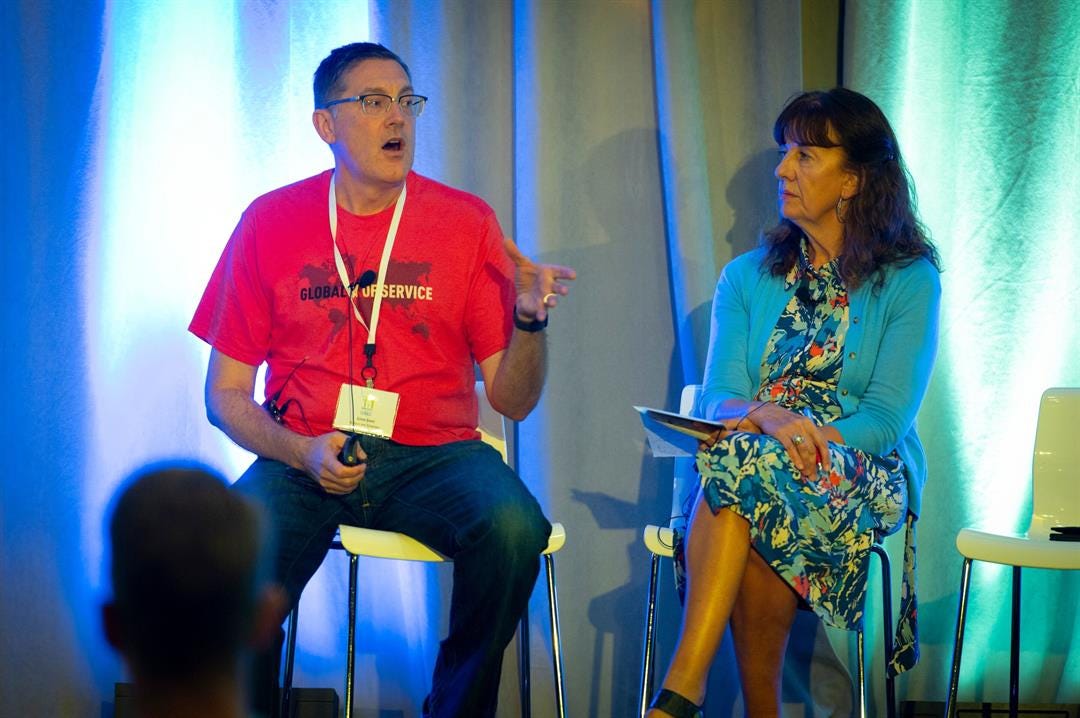Neurosciences Build Muscle in Indy, Focus on Future
 Eli Lilly and Company Senior Medical Director John Sims and Indiana CTSI Chief Operating Officer Carmel Egan discuss neuroscience during the 2019 Indiana Life Sciences Summit.
Eli Lilly and Company Senior Medical Director John Sims and Indiana CTSI Chief Operating Officer Carmel Egan discuss neuroscience during the 2019 Indiana Life Sciences Summit.
Subscriber Benefit
As a subscriber you can listen to articles at work, in the car, or while you work out. Subscribe NowIndiana’s might in neuroscience research is undeniable, says Indianapolis neuroscientist Dr. Bruce Lamb, adding that “it’s striking to me how fast it’s all moving—Indiana very quickly becoming a national leader in neuroscience.” While Lamb believes the building blocks have been in place for a number of years, he characterizes a recent $36 million grant for an Alzheimer’s disease drug discovery center, aimed at moving therapies to the patient, as helping to complete the picture. While Lamb and other neuroscience experts tout the progress, they also see opportunities to form deeper connections among each piece to form a stronger whole.
Central Indiana has a strong resume for neuroscience R&D: Dr. Christopher Callahan leads the Indiana University Center for Aging Research focused on care and support; the Indiana Alzheimer Disease Center has operated here for nearly 30 years; IU neurologist Dr. Liana Apostolova has secured $45 million in funding to lead a national consortium on early-onset Alzheimer’s disease
“But the one piece I felt like we were perhaps missing was the connection between the basic science and animal models to how do we deliver things to patients?” says Lamb, executive director of the Stark Neurosciences Research Institute at the IU School of Medicine. “The drug discovery center is a key link in that. The whole goal here is to identify new targets, move those forward so we can get ultimately to therapy on those new targets, which then can go into clinical trials that are going on here. It’s one of the big pieces I would argue we didn’t really have, but I think that really creates a complete picture—360 degrees in terms of the Alzheimer’s research program.”
Callahan, chief research and development officer at Eskenazi Health in Indianapolis, believes the vibrant neuroscience R&D community in Indiana is also due to successfully connecting each link in the chain.
“To really get things from the bench out into clinical practice, you have to have those different groups of researchers and clinicians working together and communicating with each other. We used to have the notion that we might make a basic discovery, put it in literature, then it would take on a life of its own. Or clinical doctors would assume basic scientists would just know what some of the clinical issues were,” says Callahan. “One of the things Indiana has been able to do is not only build each of those groups, but also have them interacting in a way that it looks more like a cycle, rather than disparate silos or scientists.”
As the depth of Indiana’s neuroscience expertise has steadily increased, Lamb believes even more momentum could be discovered by ensuring scientists who occupy “different worlds” have open communication lines.
“We’ve had so much growth over such a short period of time, we struggle sometimes to know even what each other is doing. Obviously, that’s critically important in terms of us reaching our goals of having something to help patients and their families,” says Lamb. “That’s one of our continuing struggles; we’re such a large group now, how do we make sure everybody knows what each other is doing? And how do we take advantage of the synergies that exist across these different groups?”
Callahan says Indiana has also been a leader in “re-balancing” neuroscience research efforts broadly, which has been a struggle at the national level, where much of the focus is on discoveries and less on patients already in the trenches of the disease.
“Among the aging baby boomers and the generation before them, are millions of people who have already developed neurodegenerative diseases. Indiana has been a leader in, ‘Yes, absolutely, search for a cure, but let’s also work to organize services and support for patients and families already living with these diseases. That’s where a lot of the work of the Center for Aging Research comes in.”
The private sector also plays an important role in Indiana’s neurosciences ecosystem. While efforts at Eli Lilly and Company haven’t been without bumps in the road, the Indianapolis-based drugmaker recently earned FDA approval for a migraine drug, and its experimental Alzheimer’s drug, solanezumab, continues through its Phase III clinical trial.
A discovery that changes the lives of patients suffering from neurodegenerative diseases could come in any form, and many believe central Indiana could be the place to produce a breakthrough.
“From a business perspective, I think a lot of times we think the economic development side of this is embodied by a pill that’s going to cure a disease—and that would be extraordinary, and that day can’t come soon enough,” says Callahan. “But there are all kinds of problems waiting for a solution today that are far short of a cure—but very important to people living quality lives.”
Callahan says, looking at neurodegenerative diseases through a business lens, there are “hundreds of opportunities” to help older adults and those with dementia live independently in their homes for longer.
Callahan says it’s not easy work to accumulate the talent to move discoveries from the bench to bedside, but Indiana has built a field of nationally recognized experts.
Lamb says local leaders are working to find better ways to communicate and create synergies in central Indiana’s burgeoning neurosciences groups.
